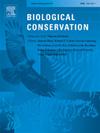A case for occupancy as a state variable for wild bee monitoring
IF 4.9
1区 环境科学与生态学
Q1 BIODIVERSITY CONSERVATION
引用次数: 0
Abstract
Reports of widespread pollinator declines, data deficiencies, and inabilities to assess status and trends underscore the need for wild bee monitoring. Chief among the challenges with wild bee monitoring is identifying monitoring objectives and state variables. Here we make the case for considering occupancy, the proportion of area occupied, as a primary state variable of interest for monitoring wild bee populations. A focus on occupancy can help to resolve some of the current complications arising from population monitoring of bees. We highlight the strengths of occupancy specifically in the context of wild bee monitoring, drawing from achievements of current monitoring programs of other taxa. We provide guidance for incorporating occupancy models into the design of current and future wild bee monitoring efforts and address important sampling biases to consider when monitoring bee populations. We also stress the importance of developing bee monitoring objectives that result in actionable conservation or improved scientific understanding. Our viewpoint provides a framework for kickstarting monitoring efforts that will better lead to effective conservation actions for wild bees.
求助全文
约1分钟内获得全文
求助全文
来源期刊

Biological Conservation
环境科学-环境科学
CiteScore
10.20
自引率
3.40%
发文量
295
审稿时长
61 days
期刊介绍:
Biological Conservation is an international leading journal in the discipline of conservation biology. The journal publishes articles spanning a diverse range of fields that contribute to the biological, sociological, and economic dimensions of conservation and natural resource management. The primary aim of Biological Conservation is the publication of high-quality papers that advance the science and practice of conservation, or which demonstrate the application of conservation principles for natural resource management and policy. Therefore it will be of interest to a broad international readership.
 求助内容:
求助内容: 应助结果提醒方式:
应助结果提醒方式:


